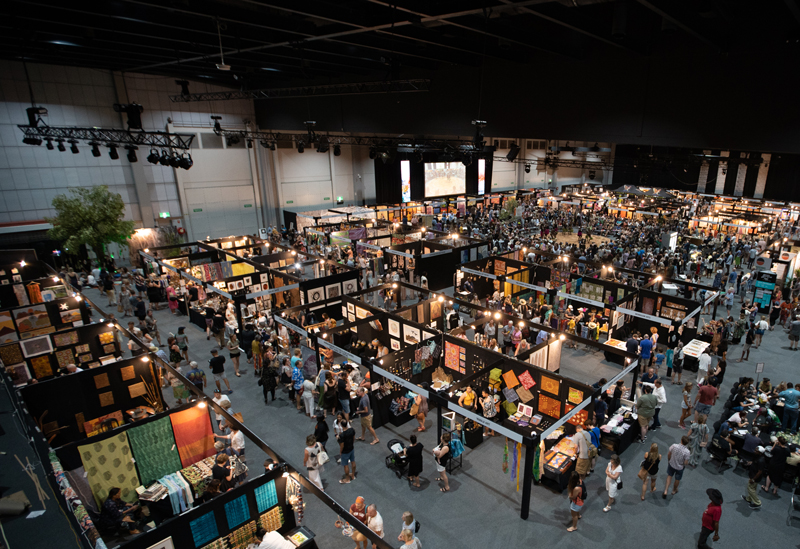
The move by Australian Indigenous artists and arts events into the virtual space, forced by the Covid-19 pandemic, looks set to leave a lasting legacy. Audiences and markets have responded to the digital opportunities being presented and, while everyone longs for a return to “real life” experiences, in the future they will go hand in hand with virtual offerings.
The Darwin Aboriginal Art Fair was already processing fifty registration applications from art centres around the country when the pandemic threw all their careful planning into doubt. In the early days of the lockdown they remained quietly optimistic that circumstances would change. But by mid-April the DAAF board, membership and staff, headed by director Claire Summers, realised that to proceed would be irresponsible.
Their caution was reflected by the participating art centres, whom they had canvassed intensively when the lockdown came in: artists were safer staying in their homelands. So, the DAAF would be going online. Expanding on their existing embrace of social media, they suddenly had to become IT experts and video producers.
The learning curve was steep but, considering the worrying outbreaks in other parts of the country as well as the volatile border arrangements, there was considerable relief that they made the right decision vindicated by the audience response. “There is a real drive to connect,” says Summers. “People are saying Oh my Goodness, that means I can actually come this year!” The artist-run workshops, for example, to be delivered remotely from wherever the artists are living, have already sold out.
“There is a real drive to connect,” says Summers. International players, like Australian embassies from their locations around the world, and Tourism Australia, are urging them to retain this online outreach in the future, “so they can share Australia’s rich cultural heritage with their networks.” Feeding into the response has been the Black Lives Matter movement: “It has made people aware of their responsibility to connect with First Nations. Art centres are a safe place to do this, where audiences will hear the story-telling and messages direct from remote Australia.”
All this amounts to a “wonderful outcome for a difficult year,” which looked like it would have a devastating impact on art sales. But that downturn may not eventuate or not as severely as feared, as many art centres are already active in the online space, and it’s working for them.
The APY Art Centre Collective brings together art centres from the Anangu Pitjantjatjara Yankunytjatjara Lands in the far north of South Australia. They have a gallery in Sydney and a gallery with a studio in Adelaide, where their manager Skye O’Meara has been based during the pandemic. To get the art to consumers in the crowded online post-Covid environment, they have been curating “micro shows” through Instagram, Facebook and Twitter, providing images, a background story, artist profiles and some understanding of their practice.
O’Meara has been “blown away” by the result: “We have made a really good income through Covid. All our years of hard work, building up our social media, and channeling through to our website, have paid off. We are making sales.” She puts this down in part to the stay-at-home experience for many, leading them to focus on their domestic surroundings. An increased interest in furniture and homewares has worked well for art sales. Education around the economic empowerment of Indigenous people has also contributed: “Our business model is attractive to consumers because it offers the highest level of return back to communities.”
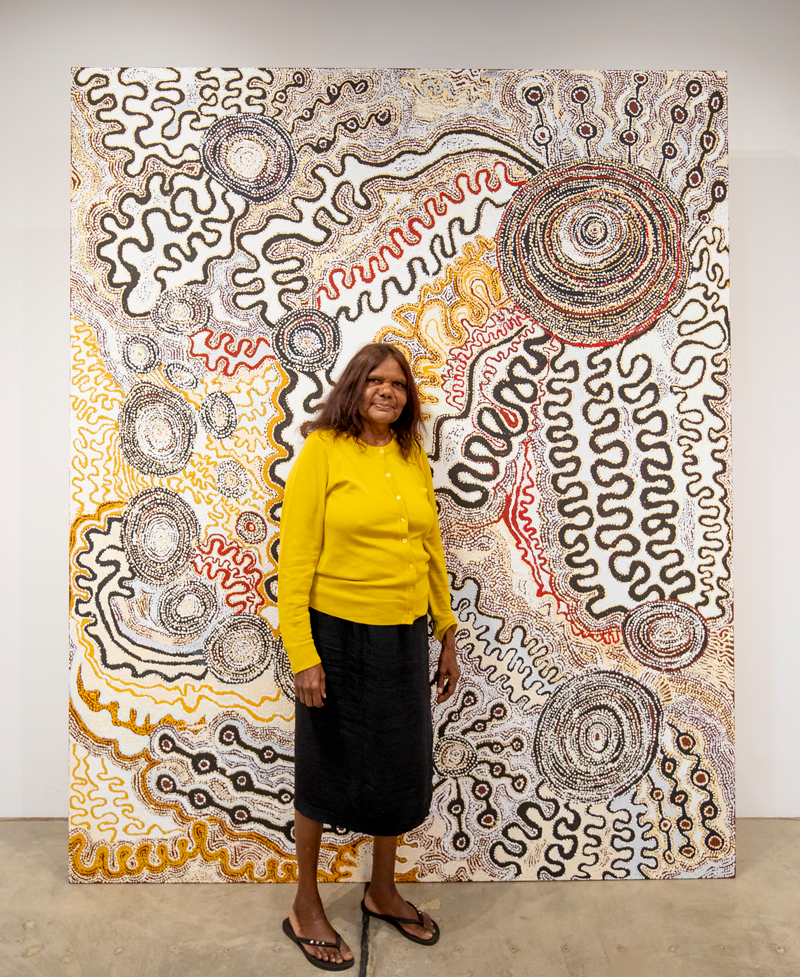
Warlukurlangu Artists are based in the Warlpiri communities of Yuendumu and Nyirripi, north-west of Alice Springs in the Northern Territory. They also have experienced very good internet sales, says manager Cecilia Alfonso, and almost every commercial interaction has been accompanied by “a really nice exchange”. Over her nineteen years in the industry, she has seen many Australians looking for ways to engage with Aboriginal people, but this year even more so, with Black Lives Matter seeming to make the difference: “We’ve been overwhelmed by the expressions of good will out there.”
Both managers say that economic success for art centres is just as important as their cultural project. “We don’t talk nearly enough about business within the art centre context,” says O’Meara. “The industry is at risk of becoming stagnant because of that.” She describes the APY model, for the individual art centres as well as the collective, as “social enterprise” and their ventures in Sydney and Adelaide as “start-ups”, which are complementary to, not in competition with, their gallery and event partners.
“We’re focused on sustainability,” she says, “on supporting a brilliant future for our art and artists because of the positive impact this has on communities. Galleries do a tremendous job, and the top galleries can do things we can’t do, like look after the stars, but the next generation is not a priority. Our model has established that there’s room for both approaches … It was never the case that we would take over the marketing of APY artists. Our focus is on opportunities that didn’t previously exist, with a fierce determination to increase income.”
In this regard, she and Alfonso are on the same page. Earning income, says Alfonso, is the “number one” motivation for Warlukurlangu’s artists. The centre’s “community development” model – a commitment to giving everyone who comes through the door the opportunity to earn – sees them servicing some 800 artists across their two communities. This makes them the biggest art centre in the region, as well as one of the most commercially successful, reflected in their 2018–19 turnover of close to $4m, with a distribution of $2m in artists’ payments.
They were again looking forward to a record financial year when Covid hit, but the challenge now is not so much being deprived of opportunities for sales, says Alfonso, as being able to keep up with the demand in the current circumstances. The art centre has staged a controlled reopening in both communities, but with numbers in the studios restricted and artists’ lives disrupted, their stock has been slow to build up.
The art fairs are normally very important to their business in the second half of each year. Alfonso, who is a longtime DAAF board member, is keen to see whether the virtual experience this year stimulates a spike in sales. Quantity won’t be the only measure, as their range is unusually broad, from the $15 decorated object to the $5,000 paintings.
That lower range serves the business in a number of ways. Young artists often start with decorating small objects. The art centre sends each one to market with an associated traditional story and identifying tag: “It’s crazy the work involved, but it’s employment, and we can get $10,000 orders for the objects from gallery shops. We also wouldn’t have the top-selling artists that we do now if we weren’t committed to giving everyone a go.”
Karen Napaljarri Barnes is a case in point, starting at the studio when she was just eleven years old, shadowing her grandmother Judy Napangardi Watson. Today her brilliantly colourful, boldly graphic works depicting birds and animals routinely sell for thousands.
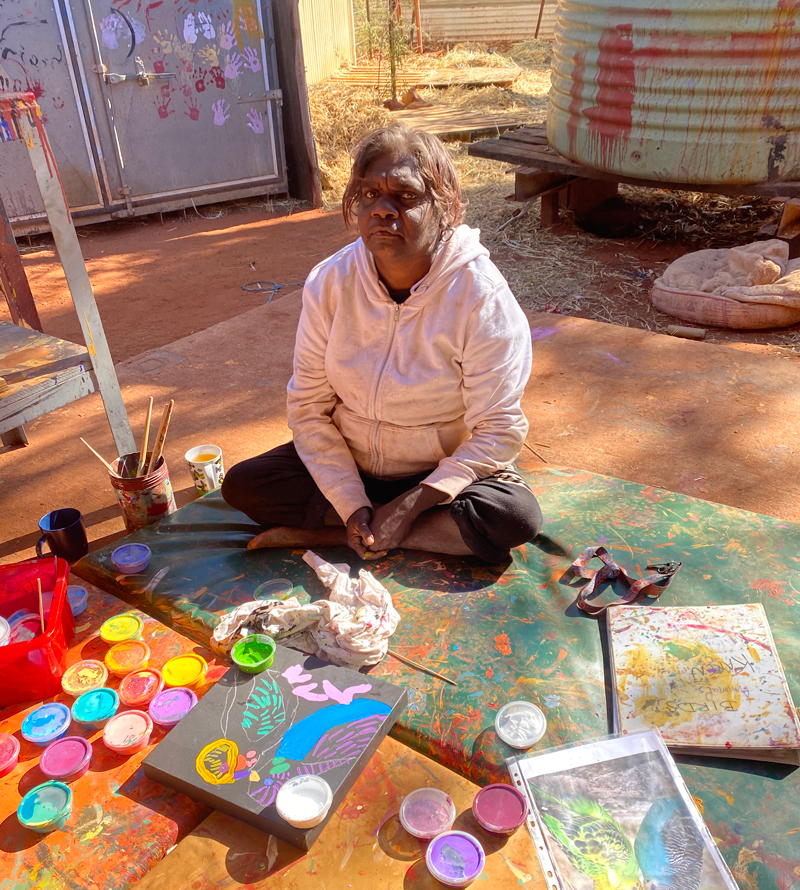
The APY art centres are much smaller. Remoteness and under-resourcing is a fundamental challenge for them: “Even for the most talented team it’s still a six-hour drive from Alice Springs. So it’s great to have a space where artists can more readily pursue new media, like photography, and develop relationships that help build their careers.” This is what is happening in the studio in Adelaide where some 30 artists work, most having moved to the city to access health services.
Career development underpins sustainability argues O’Meara. Marketplace events are good for selling work, but they don’t really contribute to an artist’s development. For non-Indigenous artists, the space where this happens, by having a first solo exhibition for example, is often the ARI (artist-run initiative). There is no parallel for Indigenous artists, who can show for years in group shows and marketplace events before getting a solo opportunity.
O’Meara distinguishes the “top tier” marketplace events. They are “a really important part of art centre economic models and for some art centres, even in our region, up to 30% of their annual income comes from them.” DAAF is one such and she commends them for their “expanding professional opportunities”, and “fantastic public programming”. Other major events like the National Aboriginal and Torres Strait Islander Art Awards (NATSIAAs ) at the Museum and Art Gallery of the Northern Territory in Darwin, Desert Mob at the Araluen Arts Centre in Alice Springs and the Tarnanthi Festival in Adelaide also deserve plaudits for “doing what art centres have had to do, pivoting and making opportunities happen.”
Mankaja Arts Resource Agency at Fitzroy Crossing in the far north of Western Australia in some ways found themselves less ready for the sudden shift to virtual, but existing partnerships and collaborations helped bridge the gap and they too have done “a lot better than we expected,” says manager Belinda Cook.
After a worrying early period when there were Covid-19 cases in the nearby towns of Broome and Halls Creek, and most Mankaja artists retreated to their isolated communities, they are feeling relatively safe now in Western Australia. The art centre remains closed to visitors but the artists themselves are carefully and gradually returning. Of over 250 members, there are fifty to seventy regulars and fifteen to twenty “avid users”.
Before the pandemic, the centre had a website and were active on social media but the restrictions “highlighted the need to get up to scratch” with their online presence. Luckily they had gallery partners poised to make the shift online. A virtual exhibition at The Junction Co. in Port Hedland sold well, while another, of works on paper, at Aboriginal Contemporary in Sydney sold out “pretty much on the day of opening”: “We’re finding that people have become much more confident about digital sales.”
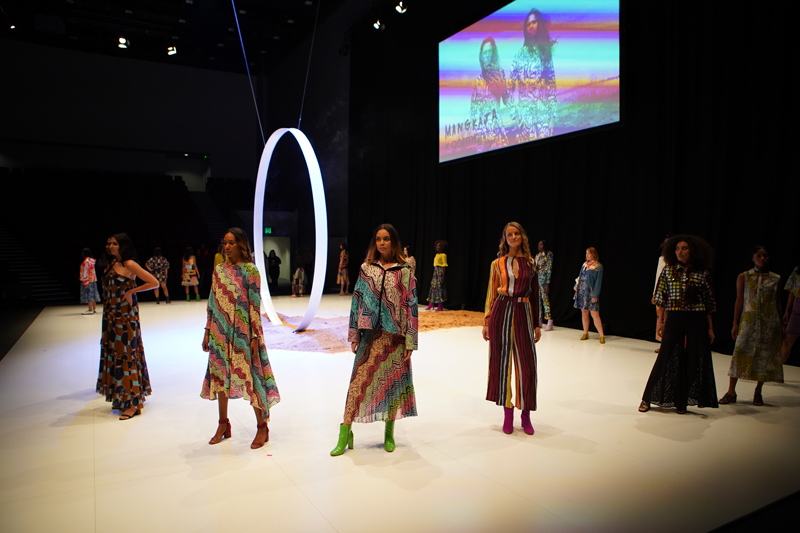
Mangkaja’s established collaboration with Gorman (the clothing, accessories, homewares label) had also increased their visibility for a whole new audience. Then the Black Lives Matter effect kicked in: “There was a lot of tagging by influencers of Indigenous art organisations and literally 3,000 people were suddenly following us.” Whether that translates to sales in the longer term it’s hard to say, but “people are looking, becoming aware of us through those platforms.”
Cook says DAAF will be a great opportunity for seeing how the whole virtual process works, “a good testing and training ground.” “What they’ve done is not too technical, it’s easy to use.” She has already drawn lessons for the sales facility on the Mankaja website: it’s too “clunky”, DAAF’s is a much better model.
While Mankaja are sending out new work to DAAF – the painting, sculpture, works on paper, and jewellery produced during the Covid-pandemic period – and also have finalists in the NATSIAAs, they’re just as excited about having these events come to them. “We’re doing a big physical launch here for DAAF and will project the awards ceremony in Fitzroy Crossing. It’s great for our community. In the past these experiences were only for whoever went to Darwin.”
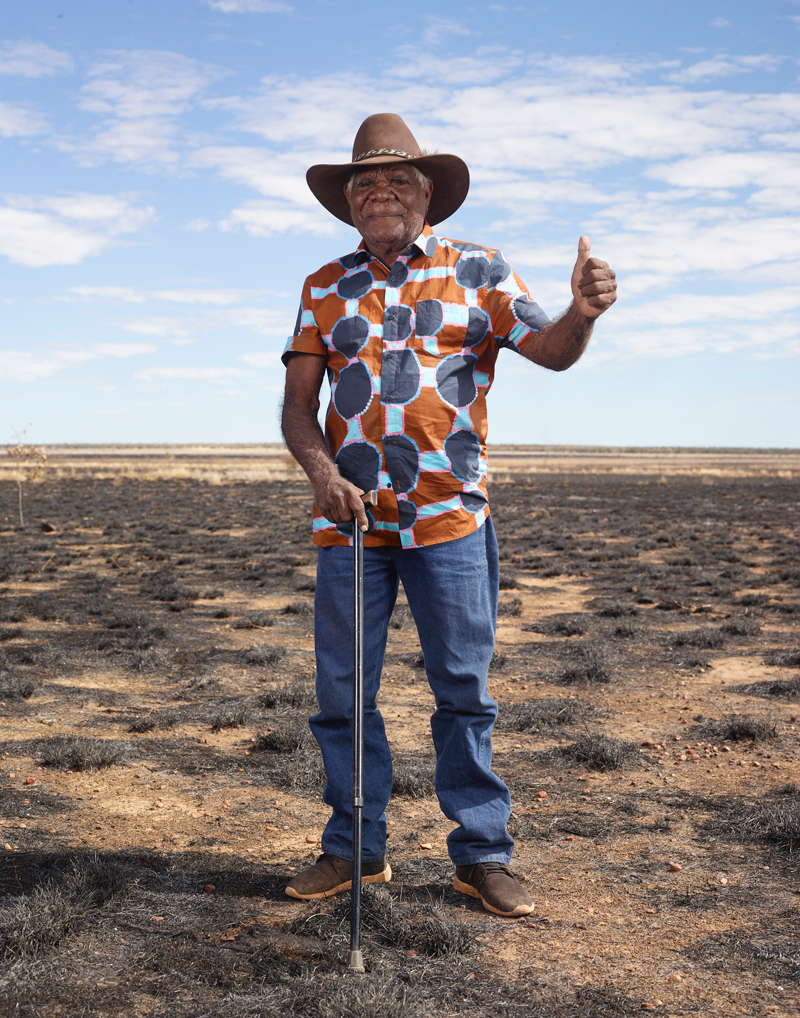
After these highlights, it will be time to regroup: as with Warlukurlangu, stock is getting low. “We’ll have to manage the expectations of galleries and what we can achieve. It will be another six months for an artist to generate a solo show.”
Pursuing training and projects with mentors and collaborators at long distance is also being done virtually. Artists have been workshopping on Zoom with Perth-based jeweller Jess Jubb. Zoom has also allowed artist John Nargoodah to continue working with Sydney-based object designer Trent Jansen; the pair have previously shown their work at Gallery Sally Dan-Cuthbert In Sydney, at Melbourne Design Week, and New Zealand Design Fair. The virtual ice having been broken, the approach is promising for the future, with obvious gains in time and cost.
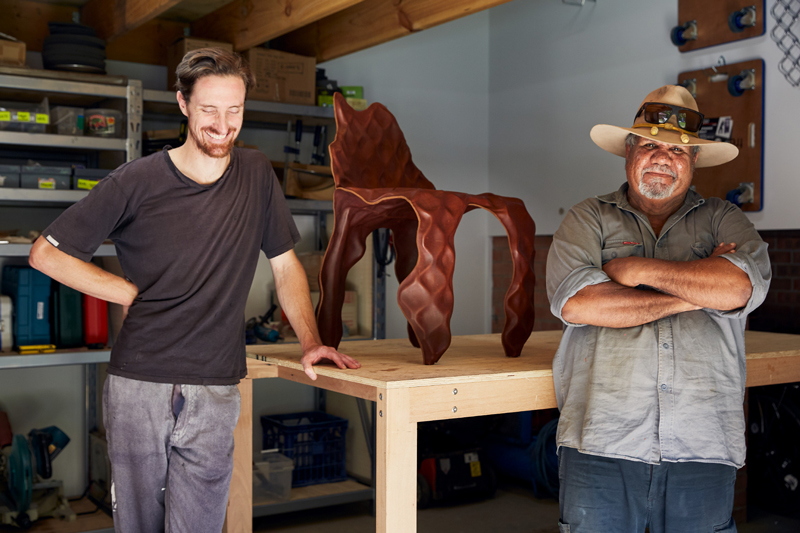
On the management side, Cook says online meetings and catchups have been vital during the pandemic period, allowing art centres in the region and their peak body, ANKA (the Arnhem, Northern and Kimberley Artists), to jointly problem-solve and present a united front to government on their funding priorities: “It’s helped us work through the isolation that we experience at the best of times, being remote. That has been a really positive shift and clever use of technology that I hope will continue in some form going forward.”
In the far north on the other side of the country, the Cairns Indigenous Art Fair is also going exclusively online this year. Like DAAF, they were well down the track with their planning when Covid-19 struck. Similarly, they canvassed the views of artists and communities on Cape York Peninsula and the Torres Strait Islands, before taking the lead to do a virtual fair. Working with Cairns-based production companies and community videographers, they built partnerships with communities to make their own content – short films that will show cultural practice, fashion and music, as well as artist interviews supporting their online exhibitions.
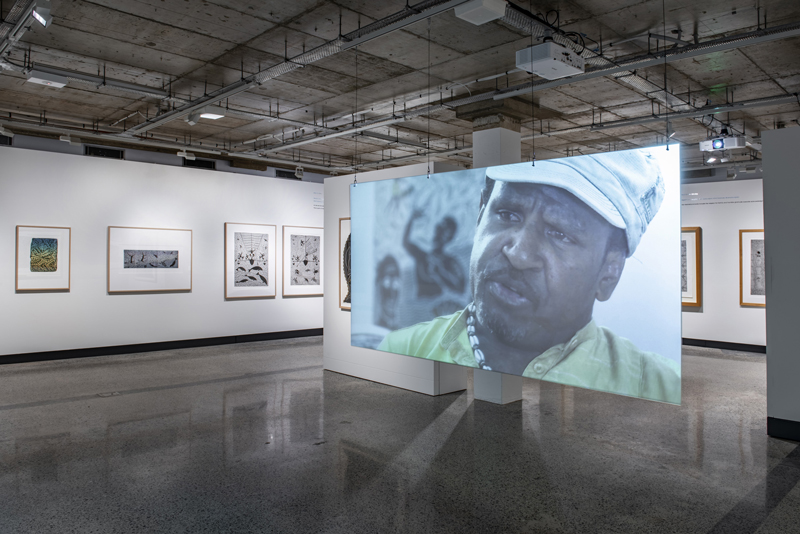
In the past the focus has been on the work of art centres on the Cape and Torres Strait Islands. Now artistic director Janina Harding has taken a more inclusive approach, trying to expand CIAF’s footprint to the whole of Queensland, embracing independent artists and their varied art forms: “It’s about sharing stories, about everything we do when we’re talking about our culture.”
She has been amazed by the way people have taken up the opportunities: “Covid-19 hurt a lot of people. Being stuck in communities, their movements restricted, it took our people back to the mission days, especially for our Elders. We didn’t know if artists were in the right mindset to produce any art, but it has all come together in the end. It shows our resilience. It made the artists feel good again, to be producing their art, they were back in their comfort zone of culture. And CIAF 2020 – The Cultural Evolution, is the embodiment of our people and cultures embracing technology.”
A feature of this year’s CIAF is an exhibition Harding jointly curated with Hetti Perkins, Undercurrents – Cook 2020. It shows the artists’ “extraordinary and varied take” on Cook and the “whole stupidity” of colonisation: there’s the sharp critique of its legacy in an Endeavour made of ghost nets, the assertion of prior occupation by “these powerful strong people” in the shields by Paul Bong, and the rain effigies and masks by Obery Sambo.
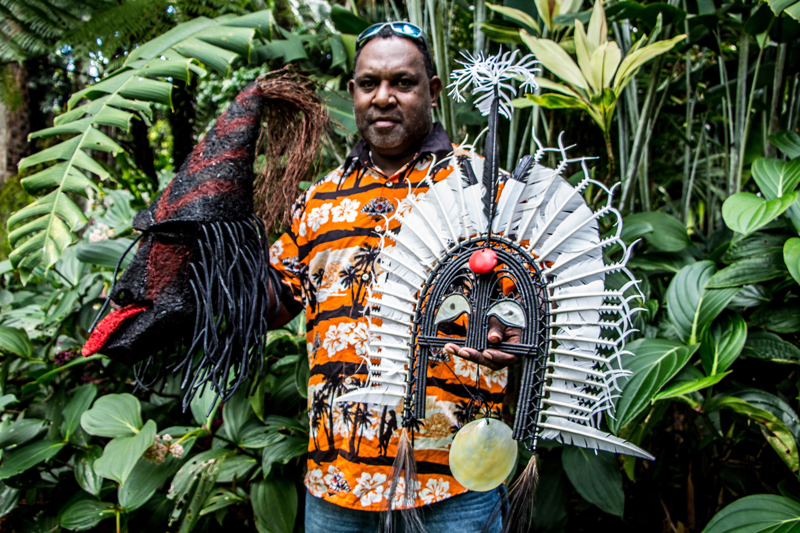
Sambo, of the Meriam people of Mer (Murray) Island in Torres Strait, now lives in Townsville but practices his art with the age-old Meriam techniques taught to him by his father, “a cultural Elder of Elders”, and uncle. He sees contemporary short-cuts, like using glue instead of the original binding techniques, as “corrupting”, as “trickery”. He’s been participating at CIAF since 2010.
In some ways he is disappointed to see the fair going online: “Because I would rather be face to face talking to people about my art work, meeting people, having them physically viewing my works.”
He also leads a dance troupe and that’s disappointing too, to not actually perform at CIAF, but he can see the upside. With the whole fair going virtual, “it’s going to be viewed all over the world.” In that, there’s both opportunity and challenge. Normally, when someone walks into a stall at the fair, they might buy one art piece, someone else, another one. Online “we might end up with thirty to fifty commissions – we’ve got to be ready for that!” Another attraction is that this year, CIAF will return 100% of their sales to artists (this is also DAAF policy).
Toby Cedar is another TSI artist now living “down south”, in NSW. He and Sambo are close. Cedar is known for making traditional and contemporary head dresses, but this year he has tried something new, a two metre-long shark from pearl shells and resin: “That tested me”. In a filmed performance, featuring the shark and four shark masks, he and his two sons, Braden and Elijah Cedar, sing and dance in honour of Sambo and his family: “The shark dance belongs to that group.”
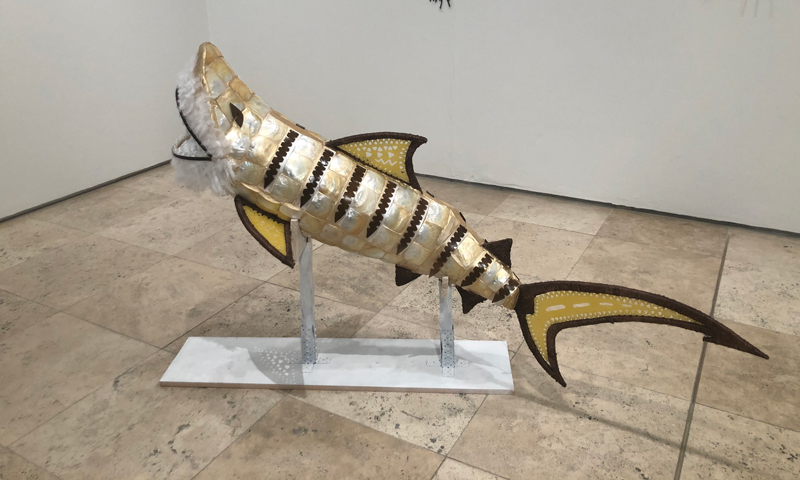
Like Sambo, he’ll miss the networking of the usual CIAF, especially the exchanges with other artists – “what materials they use, what’s coming up for them” – and having one-on-one contact with buyers: “Every year I look forward to this time of year … there’s so much talent through the art world, it amazes me, I love going to see performances, the fashion.” That stimulation helps him in creating his new work. But he’s philosophical and can see the opportunities in going online, the broader international reach – good for artists and for CIAF. Covid-19 restrictions caused Cedar to lose his everyday job, but that has meant more time for his art. “I’m always running behind, finishing at the last minute. This year I’ve had plenty of time to do it and hopefully it will be a success.”
All going well next year should see CIAF return to a live format, but the lesson of this year is that they will maintain an online presence in the future says Harding. “We’ll be in a position next year to train our own people to do the filming and will be able to live stream some of the events.” What has been a necessity this year has opened up the participating artists and art centres to communicating online: “We’re going to communities and people are happy to sit and yarn, to tell their story in front of the camera.”
In the year of the pandemic DAAF adopted the theme, “Connecting to Country, From Our Home to Yours”. In the post-pandemic world we are all dreaming of, perhaps they could add “and back again” – the world coming in, artists and country going out, in the two-way exchange that Indigenous people so often invoke.
